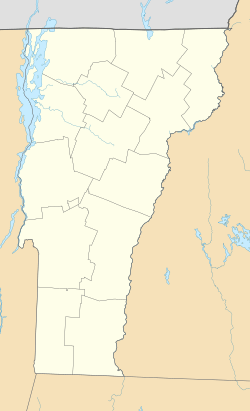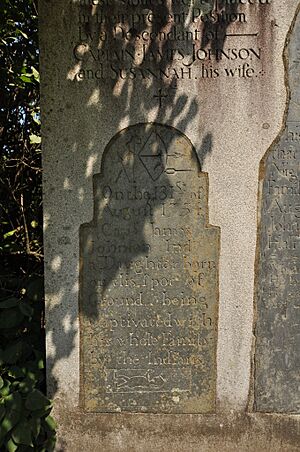Indian Stones facts for kids
Quick facts for kids |
|
|
Indian Stones
|
|
 |
|
| Location | VT 106 at Knapp Brook Rd., Reading, Vermont |
|---|---|
| Area | less than one acre |
| Built | 1799 |
| NRHP reference No. | 74000356 |
| Added to NRHP | November 20, 1974 |
The Indian Stones are two old stone markers in Reading, Vermont. You can find them along Vermont Route 106. These special stones were put up in 1799. They remember an event from 1754 involving Native Americans. These stones are the oldest markers of their kind in Vermont, and some of the oldest in the entire United States! In 1918, they were placed together in a bigger granite slab. Later, in 1974, they were added to the National Register of Historic Places, which lists important historical sites.
Contents
What Do the Indian Stones Look Like?
The Indian Stones are found in a small area next to Route 106. This spot is in southern Reading, where Route 106 meets Knapp Brook Road. You will see three granite steps that lead up to a large granite slab. Inside this slab, two smaller slate markers are set.
The area around the markers has small bushes and trees. There is also a state sign that tells more about the history.
Messages on the Stones
The large granite slab has a message carved into its top left corner. It says that in 1918, these stones were placed there by a family member of Captain James Johnson and his wife Susannah.
Below this message, you'll find the first slate stone. It has a special shape with stepped shoulders. This stone reads: "On the 31st of August 1754, Capt James Johnson had a Daughter born on this Spot of Ground, being Captivated with his whole Family by the Indians." This means Captain Johnson's daughter was born right there while his family was taken by Native Americans. The stone also shows pictures of tools.
Next to this first stone is the second slate slab. It has similar decorations. This stone says: "This is near the Spot that the Indians Encamp'd the Night after they took Mr Johnson & Family, Mr Labarree & Farnsworth, August 30th 1754, and Mrs Johnson was Delivered of her Child Half a mile up this Brook; // When troubles near the Lord is kind, / He hears the Captives crys. / He can subdue the Savage mind, / And learn it sympathy." This stone marks where the Native Americans camped after taking the families. It also mentions Mrs. Johnson giving birth nearby.
The Story Behind the Stones
The story of the Indian Stones begins on August 29, 1754. This was during the French and Indian War. A group of Native Americans attacked the Fort at Number 4 in Charlestown, New Hampshire. They took members of the Johnson and Farnsworth families as captives.
A Journey and a Birth
The captives were forced to march. On the second day of this journey, Susannah Johnson gave birth to her daughter, Elizabeth Captive Johnson. She was born right near where the stones are now.
Eventually, all the captives were bought back by French people in Montreal. They were able to return home by 1760.
Remembering the Event
Susannah Johnson returned to the place where her daughter was born many times. In 1796, she wrote a book about her family's difficult experience. In 1799, she was sure she had found the exact spot. She hired a stonecutter to make the two slate markers. She wanted one stone to be at the birthplace and the other at the nearby Native American camp site.
We don't know the exact date the stones were first placed. But it was likely before Susannah Johnson passed away in 1810. Her instructions were not followed exactly. The two stones were placed side-by-side, not far from where they are today.
Moving the Stones
In 1918, some of Susannah Johnson's family members had the two stones placed into the larger granite slab. They put them at the same site. The stones are now in a slightly different spot. This change happened because of road improvements on Route 106, which required the memorial to be moved.



